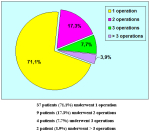Hypospadias is a congenital malformation of the male and female genitalia, resulting from incomplete development of the urethra. The term hypospadias is derived from the Greek language and refers to an opening on the ventral surface of the penis that is not at the apex of the glans. The abnormal urethral opening may be anywhere along the shaft of the penis or may be on the scrotum, or even in the perineum. Hypospadias may be associated with curvature of the penis during erection.
Classification of hypospadias is based on the location of the urethral meatus after release of penile curvature:
- glandular – subcoronal (50% of cases)
- penile (20% of cases)
- scroto-perineal (30% of cases)
Problems resulting from the abnormal urethral opening include deviation of the urinary stream, modified appearance of the penis and genitalia, cosmetic and psychological sequelae having an adverse effect on patient quality of life.
Incidence of hypospadias and its associated anomalies
Hypospadias occurs in 0.3% of the male population. Urinary tract anomalies are infrequent in patients with hypospadias because the external genitalia are developed after the upper urinary tract.
Undescended testes and inguinal hernia are the most common abnormalities (10% of cases) associated with hypospadias. Patients with scroto-perineal hypospadias may have complex ano-genital malformation or chromosomal disorder. It may be possible to diagnose hypospadias in utero with the advent of more sophisticated ultrasonographers and higher quality equipment. The diagnosis of hypospadias is typically straightforward at the time of birth. Classic findings are the abnormal position of the urethral meatus and the dorsal hooded foreskin, which results from incomplete fusion of the foreskin secondary to the absence of the urethral spongiosum.
Surgical treatment of hypospadias
The goal of hypospadias surgery is to reconstruct a straight penis with the meatus in the normal position, as well as having a forward directed stream and the ability to have intercourse. The optimal time to perform hypospadias repair is between the ages of 6 and 15 months, when the psychological effects of general surgery are minimal.
Long-term follow-up of patients with hypospadias is difficult to evaluate since the surgeon’s assessment of the outcome of hypospadias is clearly different from the patient’s. All patients should therefore be followed into adolescence and offered the option of further cosmetic correction if not satisfied. In summary, the patient with hypospadias has an excellent chance of having normal sexual function, normal voiding and an acceptable cosmetic result.
Answer: General anesthesia with nasal or oro-tracheal intubation.
2. Question: How many hours does the surgery take?
Answer: About 1 hour.
3. Question: Are there any risks concerning erection?
Answer: No.
4. Question: How many days of hospital recovery are expected following the surgery?
Answer: In general, from 2 to 4 days.
5. Question: How long will I have to use a urethral catheter following surgery?
Answer: The urethral catheter must stay in place for one or two weeks following surgery.
6. Question: Are there any particular recommendations during convalescence?
Answer: During convalescence, antibiotic use is suggested until the catheter is removed. It is also suggested that sexual activity be avoided.
7. Question: When will I be able to resume sexual activity?
Answer: Sexual activity can be gradually resumed one month after surgery.
8. Question: Can I ride a bike or a motorcycle immediately after the surgery?
Answer: Yes.
9. Question: What kinds of foods and drinks should be avoided after the surgery?
Answer: None.
| Up-to-date to 12-31-2021 | |||

Summarizing table |
|||








